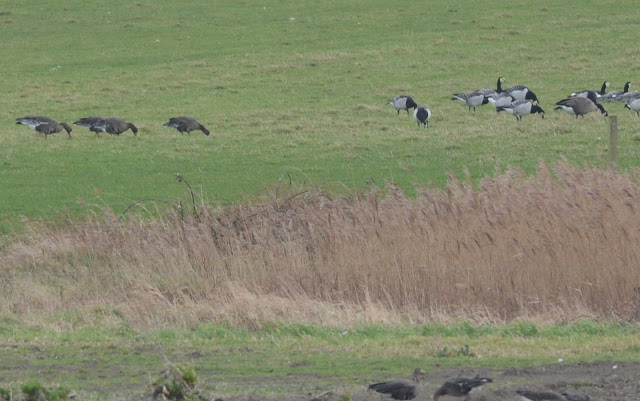Greater White-fronted Geese (GWFG): characteristics of Flavirostris and Gambelli - Part 1
This blog covers some of my own photos of GWFG here in the mid-Atlantic as well as in Ireland and Scotland, as well as photos of skins of GWFG from the National Museum of Natural History, Smithsonian Institution, and the Museum of Natural History, Tring, UK. I've put it together to illustrate some ways to tell apart flavirostris and "Western" GWFG (presumed gambelli). On the museum table, these two subspecies can look quite different, although there is overlap, but GWFG in this part of the world usually occur singly or in very small numbers with Canada or Snow Geese, so this comparison is not particularly useful! Although there is a difference in bill color, the orange tones on many gambelli and the difficulty of assessing bill color makes this not straightforward to use. This builds on features pointed out by others including Sibley (http://sibleyguides.blogspot.com/2008/11/identification-tips-for-greenland.html), Garner et al (Martin Garner & Friends, Frontiers in Birding, Birdguides) and Reeber, (Waterfowl of North America, Europe, and Asia: An Identification Guide).- Overall appearance, color and structure
- Prominence of pale fringing on upperparts and of white flank stripe
- Extent of white on tail
- Extent of black markings on the underparts
- Bill Shape
- Shape and extent of white frontal patch
- Bill color
I've looked at these for adults birds, not for birds obviously in their first year. For the most part I'm focusing on features present in flavirostris to allow this ssp to be ruled out with a high degree of probability. There is greater variability in gambelli, probably due to its much larger population and range than there is flavirostris. There are some features e.g. size that may not be that easily used on a lone bird with a different species; also there is considerable variability in flavirostris and even more so in gambelli, or birds that make it to the central flyway and Atlantic. Very small birds are however unlikely to be flavirostris.
Here is a Flickr album of photos of flavirostris from Ireland.
https://www.flickr.com/photos/23281683@N04/albums/72157688497667774
Unless otherwise stated all photos are © Clive Harris.
Here is a Flickr album of photos of flavirostris from Ireland.
https://www.flickr.com/photos/23281683@N04/albums/72157688497667774
Unless otherwise stated all photos are © Clive Harris.
1. Overall appearance
From a distance flavirostris has a dark and uniform appearance with the upperpart fringing not really noticeable at distance. Given they are usually seen with Canada Geese in the mid-Atlantic, its useful to see how typical flavirostris compare in overall color to that species. The photo below was taken at Wexford reserve in Ireland and you can see just how dark they are compared to the Canada Goose. The ssp of the Canada is unknown but it was a relatively small bird, conceivably interior, and not particularly pale. There is some variation in the overall color of flavirostris, however, with some birds being darker and more chocolatey-brown than others.
The photo below shows how typical flavirostris (upper two birds) are darker overall than birds from continental North America (lower two birds). This also shows the narrower and darker upperparts fringing typical of flavirostris, compared to gambelli.
Flavirostris have a block-headed, heavy-billed appearance, with relatively little variation. The photos below shows some typical birds. Typical features include dull, indistinct upperparts fringes and narrow/broken and wavy white flank stripes.
2. Prominence of pale fringes on the upperparts and flank stripe
From a distance flavirostris look very plain above because the upperpart fringes are narrow and brownish in color. There is some individual variation with some birds being virtually unmarked, and others with fringing well developed enough to show very thin barring. The white flank stripe is thin, often broken and typically very wavy (pointed out to me by Killian Mullarney).
The photos below show birds at the well-marked, average and less well-marked range, in terms of upperpart fringes, for flavirostris. (all three photos below Clive Harris © Museum of Natural History, Tring). Even when paler and more prominent the fringes are still very narrow.
Below are three presumed gambelli (all specimens from the Central Flyway wintering grounds) showing some variation in upperpart fringing. Typically the fringes are paler and thicker and therefore more distinct particularly at distance. These photos also show the typically more greyish-brown coloration to gambelli.
Below are three presumed gambelli (all specimens from the Central Flyway wintering grounds) showing some variation in upperpart fringing. Typically the fringes are paler and thicker and therefore more distinct particularly at distance. These photos also show the typically more greyish-brown coloration to gambelli.
 |
| Clive Harris © Smithsonian Institution (NMNH # 285628) |
 |
| Clive Harris © Smithsonian Institution (NMNH #478858) |
3. Extent of white on the tail
Flavirsotris has narrow white tips to the tail feathers and at most narrow white fringes on the outer edges of the tail feathers. As the photos below show, there some variation. (All photos immediately below Clive Harris © Museum of Natural History, Tring).
In the field, most birds show limited white tips to the tail and very little sign of white fringes to the outer edges of the tail feathers. The top 3 photos are of flavirostris from Wexford (the left most bird had the broadest white tips of the birds I photographed) and below are photos of tails of birds taken in the mid-Atlantic which show much more extensive white terminal bands and fringes.
(All photos below © Clive Harris).
http://gwfgmdde.blogspot.com/2017/10/greater-white-fronted-geese_11.html

























Comments
Post a Comment